Advertisement
These two BoatUS Members know their way around a DIY project, and know what it takes for a full boat restoration. Here's the results of their of makeovers.
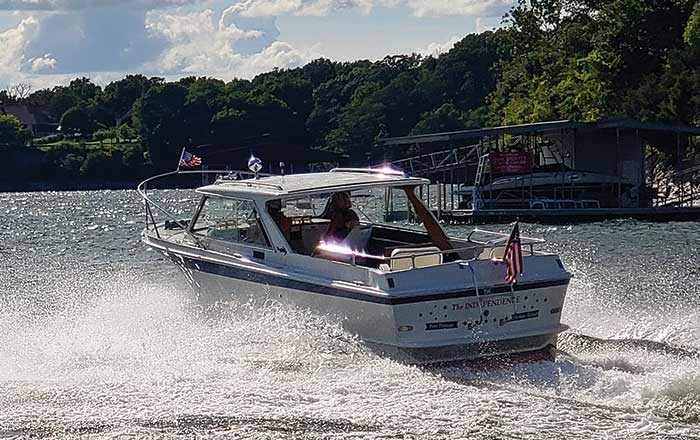
The Independence: Uniflite 23 Sport Fisherman Hardtop
I had a friend who inherited his father's 1968 Uniflite 23 Sport Fisherman Hardtop. Then it sat outside his house for 20-some years. He intended to keep it up and use it, but life got in the way and it sat uncovered for too many of those years.
I bought the boat and trailer for $1,000. A few years of work and about $40,000 later, other boaters frequently holler, "I LOVE your boat!" at me in anchorages. I'm not sure why, except that it's a rare bird on Grand Lake, Oklahoma.
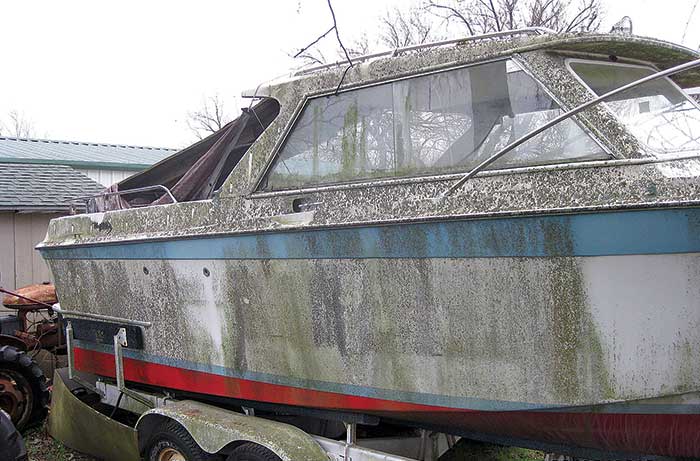
Nothing about the job was real hard, but I'm 74 and have been doing similar work on boats or houses for years. My only surprise was that so little of the original boat was still usable. So I became a reliable online customer of West Marine and Marine Parts Source.
All but about 30 square feet of flooring (in the cabin area) was rotted, so I removed the original dinette and captain's seats, table, toilet, and icebox, then cut out and removed the plywood bulkhead between the engine and the cabin area, and removed the original Chrysler 318 engine with the Paragon transmission and V‐drive. Digging deeper, I determined the metal fuel tanks were beyond their useful life and removed them (two 27-gallon tanks), plus the old fuel fills and filler hoses. The steering cable was no longer usable, so I removed the cable along with the wheel and gear box. I really wanted to save the old "Popeye" steering wheel with the spokes sticking out but couldn't make it work with the new steering gear and cable. I made a new bulkhead from 3/4-inch marine-grade plywood and replaced missing floorboards in the cabin. I removed the helm console that enclosed all instruments and helm wiring.
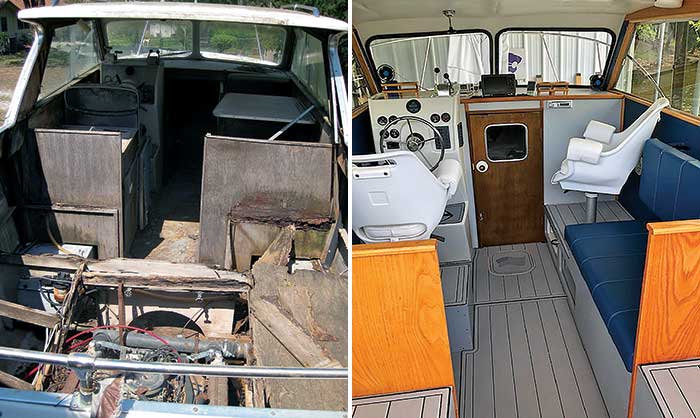
Before renovation (left) nearly all of the flooring needed to be replaced (right).
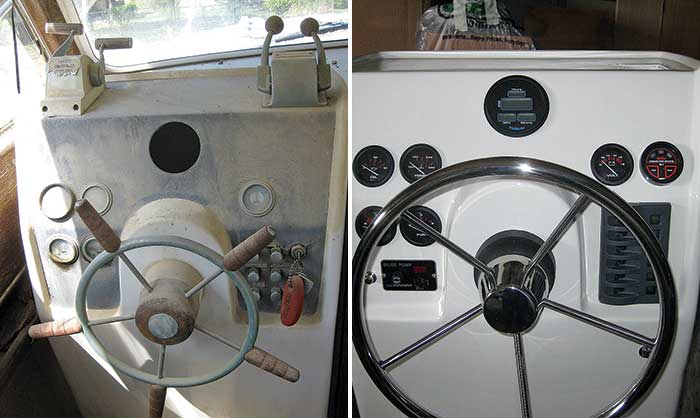
The new steering wheel (right) is a better fit for the helm then the old one (left).
I painted the bilge, then painted the marine plywood floorboards with one coat of epoxy, replaced and glassed in 2-by-12s that were used to secure the boat roof to the hull sides, removed all hardware, trim, rails (except handrails on the roof) from the boat for paint prep.
The original Chrysler Marine 318 inboard engine was beyond overhaul condition, but there are still a lot from the 1960s through the '80s, so I had no problem finding a remanufactured 318. I loaded my pickup truck with the rebuilt engine, the original Paragon transmission, and V-drive and took it all to a mechanic friend in Kansas City, who put new seals in the transmission and V-drive.
Despite my assumption, my boat was apparently never a dual exhaust boat. It came to me with brass or bronze elbows that had been mangled through the years and weren't reusable. The combined exhaust went through a muffler on the starboard side then out the only thru-hull on the stern. I bought fiberglass exhaust elbows from Marine Parts Source, which came to me with single clamps, and didn't dawn on me that I needed to double clamp it. I've since corrected that.
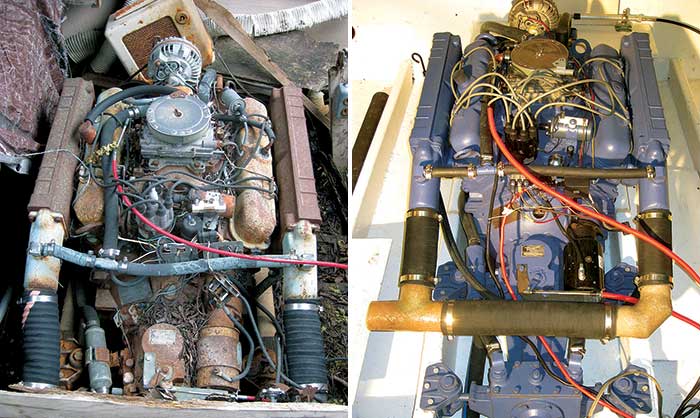
The original Chrysler Marine 318 inboard engine (left) was beyond repair, but remanufactured models can be found (right).
Then came the reassembly. I installed twin Moeller 25-gallon fuel tanks, muffler, exhaust plumbing, new steering gear and cable, new fuel fills and hoses, Fireboy Fume Detector by Xintex battery, and new cables, windshield panes, side windows and track for sliders, new prop shaft and reconditioned prop, new helm instrumentation, wiring, and gear/throttle control.
I had been keeping track of time spent on the project and was up to 452 hours when I quit taking notes. By then, I was down to remounting all the trim, cleats, rails, the fiberglass skirt around the cockpit, upholstered items, interior lights, underwater lights, new trim tabs, decals, custom built Uniflite logos, and SeaDek flooring.
We have a 37-foot cruiser but use the little Uniflite more often because it's so much easier for my wife and me to handle without help. Generally, that amounts to rafting up with friends and relatives somewhere on Grand Lake in Oklahoma to spend a productive afternoon NOT solving any of the world's problems. Very little of the original boat hardware was still usable, so I spent somewhere in the area of $40,000 on the project. And I've yet to need my annual membership to TowBoatUS.
— Darrell Gentry, Oklahoma
Lady Di, Speedliner Outboard Runabout
My wife, Diane, and I have always loved wooden boats. Our home on Legend Lake, Wisconsin, is decorated with wood boat pictures and models, so much so that visitors ask if we ever thought of buying and refurbishing a wood boat. I always said I didn't have the time or expertise. And that's true. I've made some furniture, but don't have the mechanical skills to rebuild an engine.
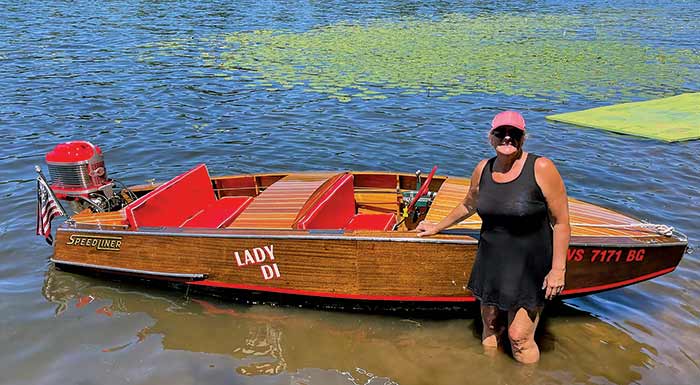
Then soon after I retired in 2018, our daughter spotted this 14-foot Speedliner, circa 1958, with a well-cared-for classic Mercury 40-hp outboard. I thought this could be a great project to take on because it required little or no mechanical work. The boat was in rough shape, with a large hole in the bottom, and the finish was completely distressed. The first summer I set my goal to strip all the hardware and flip the hull to repair the hole and complete the epoxy finish on the bottom before winter. The next summer was committed to stripping all the old finish, bleaching and sanding the complete exterior, and staining the entire boat. The following winter was all about varnish, then sand, varnish, then sand — 13 times!
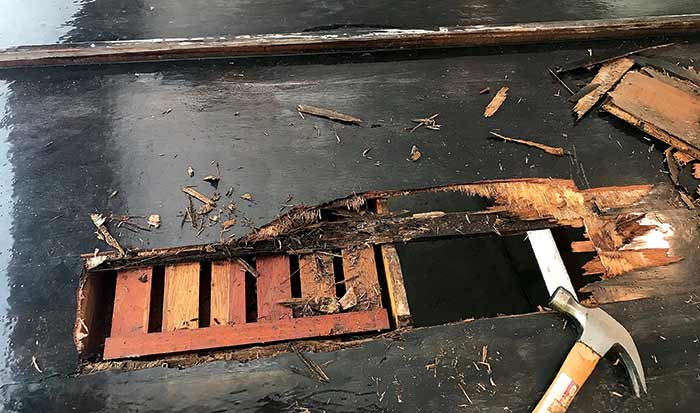

Over the course of two winters and a summer, Resch stripped all of the old finish (left), sanded and bleached the wood, stained, then varnished the entire boat (right). He used a high-quality brush instead of spraying.
As for the 1958 Mercury 45-hp, it couldn't have worked out better. We took it to a local antique engine expert to check it over. He just gave it a tune up, and it was ready to go. We've since repainted the Art Deco-styled Merc a cherry red. We continue to do little things to make it better, and we're still hunting for a period-correct windshield.
Believe it or not, we found the more than 200 hours of work to be totally satisfying. We enjoyed the process and, especially, seeing the results. It's been an amazing project to take on with my wife. Working on it together has given us a wonderful sense of accomplishment. The hardest part was researching the products and processes we should use to do the job right.
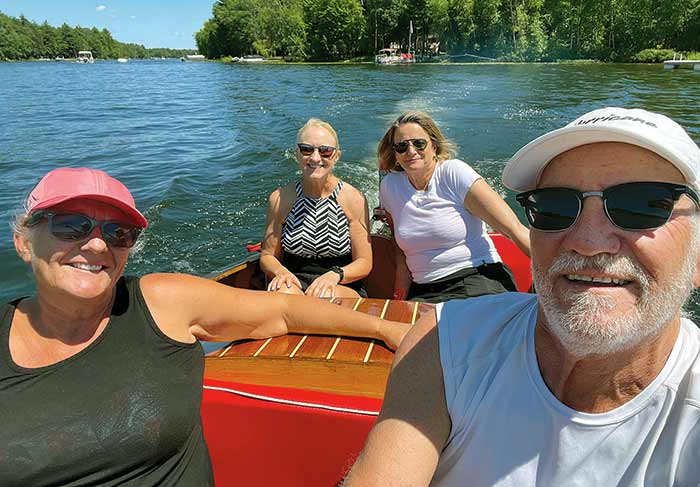
The maiden ride was Labor Day weekend 2020. We love to take rides around our chain of lakes to show if off, and we are now planning to start taking it to some wood boat shows.
— Jeff Resch, Wisconsin
